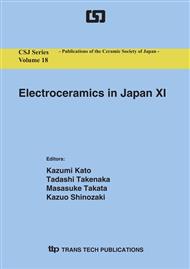[1]
H. Ohno, Science 281 (1998) p.951.
Google Scholar
[2]
Y. Matsumoto, M. Murakami, T. Shono, T. Hasegawa, T. Fukumura, M. Kawasaki, P. Ahmet, T. Chikyow, S. Koshihara and H. Koinuma, Science 291 (2001) p.854.
DOI: 10.1126/science.1056186
Google Scholar
[3]
K. Ueda, H. Tabata and T. Kawai, Appl. Phys. Lett. 79 (2001) p.988.
Google Scholar
[4]
S. B. Ogale, R. J. Choudhary, J. P. Buban, S. E. Lofland, S. R. Shinde, S. N. Kale, V. N. Kulkarni, J. Higgins, C. Lanci, J. R. Simpson, N. D. Browning, S. Das Sarma, H. D. Drew, R. L. Greene and T. Venkatesan, Phys. Rev. Lett. 91 (2003) p.077205.
DOI: 10.1063/1.1610796
Google Scholar
[5]
M. Osada, Y. Ebina, K. Takada and T. Sasaki, Adv. Mater. 18 (2006) p.295.
Google Scholar
[6]
M. Osada, Y. Ebina, K. Fukuda, K. Ono, K. Takada, K. Yamaura, E. Takayama-Muromachi and T. Sasaki, Phys. Rev. B 73 (2006) p.153301.
Google Scholar
[7]
T. Sasaki and M. Watanabe, J. Am. Chem. Soc. 120 (1998) p.4682.
Google Scholar
[8]
T. Sasaki, Y. Ebina, T. Tanaka, M. Harada, M. Watanabe and G. Decher, Chem. Mater. 13, 4661 (2001).
Google Scholar
[9]
K. A. Griffin, A. B. Pakhomov, C. M. Wang, S. M. Heald and Kannan M. Krishnan, Phys. Rev. Lett. 94, (2005) p.157204.
Google Scholar
[10]
The MCD signal is generally enhanced at the absorption edge of host materials, as a result of the Zeeman splitting of the band structure. Its intensity linearly depends on the Zeeman splitting energy that is proportional to the magnetization. Thus, MCD spectroscopy provides an important information on magnetic structures.
Google Scholar
[11]
H. Saito, V. Zayets, S. Yamagata and K. Ando, Phys. Rev. Lett. 90 (2003) p.207202.
Google Scholar
[12]
J. M. D. Coey, M. Venkatesan and C. B. Fitzgerald, Nature Mater. 4 (2005) p.173.
Google Scholar
[13]
A. Filippetti and W. E. Pickett, Phys. Rev. B. 62 (2000) p.11571.
Google Scholar
[14]
B. Lee, T. Jungwirth and A. H. MacDonald, Phys. Rev. B. 61 (2000) p.15606.
Google Scholar


